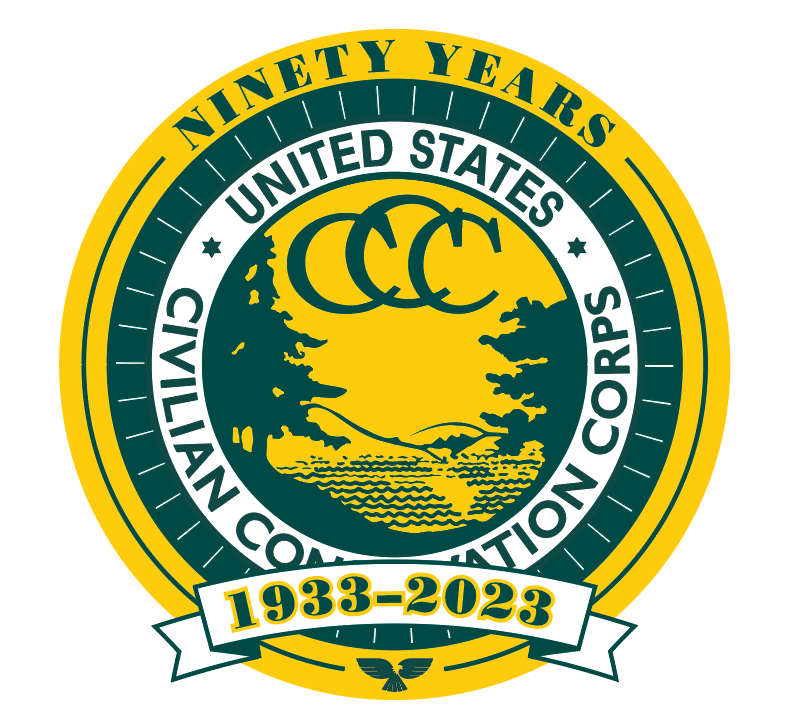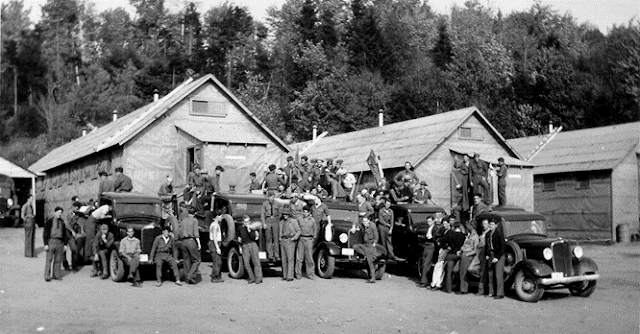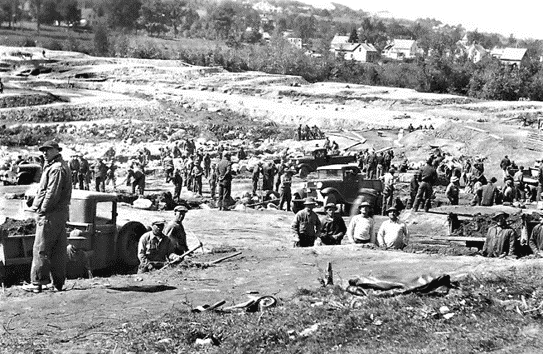Civilian Conservation Corps Celebrates 90th Anniversary
This year is the 90th Anniversary of the founding of the Civilian Conservation Corps (CCC). The CCC was a public works program that operated from 1933 to 1942 as part of President Franklin D. Roosevelt’s New Deal. It targeted single men, 18-25 years old, and WWI veterans in relief of families who had difficulty finding jobs during the Great Depression. The program provided unskilled manual labor in environmental conservation and the development of natural resources in rural lands.
During Roosevelt's first 100 days he signed the Emergency Conservation Work (ECW) Act, commonly known as the Civilian Conservation Corps. FDR proposed the CCC to Congress on March 21, went through both houses of Congress and landed on Roosevelt's desk to be signed on March 31, 1933. He proposed to recruit thousands of unemployed young men, enroll them in a peacetime army, and send them into battle against destruction and erosion of our natural resources. "I propose to create a Civilian Conservation Corps to be used in simple work … more important, however, than the material gains will be the moral and spiritual value of such work."
On April 5th, the “birthday” of the CCC, FDR signed the executive order creating the ECW/CCC. On April 7 the first enrollee was selected and by April 17 the first camp was in operation near Luray, Virginia—Camp Roosevelt.
He brought together two unused resources, the young men and the land. He promised he’d have 250,000 men in camps by the end of July 1933.
The Department of Labor, through its state and local relief offices, was responsible for the selection and enrollment of applicants. Enrollees had to be single and unemployed men aged 18-25 with families on relief. They enrolled for six months and worked a 40-hour week for $30/month. The government sent $25 a month home to the workers’ parents and the men had $5 spending money. By July 1, 1933, there were 275,000 enrollees and 10,000 supervisory personnel in 1468 camps. It was the fastest large-scale mobilization of men in US history.
Bellows Falls, VT CCC camp housed approx. 200 young men. It was located in North Westminster and had four barracks, a mess hall, recreation hall, administration building, infirmary, shower/toilet, garages, and blacksmith shop. Photo: Ellen Howard
CCC camps were located in all of the 48 states and these territories: Alaska, Hawaii, Puerto Rico and the US Virgin Islands- St. Thomas, St. John, and St. Croix. There were separate camps: white enrollees, black enrollees, unemployed veterans who served in WW I, and Native Americans who worked on tribal lands.
Photo caption: Camp Elmore CCC boys are loading up in camp trucks in front of their barracks near Lake Elmore. They are all dressed up and ready to go to one of the local towns for a dance, bowling, a movie, a restaurant, or meet some of the local girls. Photo: VT State Parks
There were approx. 34 CCC camps in or near these VT towns: Bellows Falls, Bethel, Brunswick/North Stratford NH, Cuttingsville/North Shrewsbury, Danby/Mount Tabor, East Barre, East Wallingford/ Weston, Elmore, Jericho, Ludlow, Lyndonville/East Burke, Marshfield/Groton, Mendon, Middlesex, Milton/Sand Bar Bridge, Montpelier/Camp McKee, Montpelier/Wrightsville (Camps Wilson, Weeks, Cushing), Moscow/Stowe, Northfield, North Thetford, Peru, Plymouth, Proctorsville/Cavendish, Poultney, Ricker Mills, Rochester, St. Albans, Sharon, Underhill Center/ Ethan Allen Firing Range, Waterbury/Camp Charles M. Smith, Waterbury Village, West Burke/Sutton, Wilmington, and Windsor. Supply depots: Barre/Quartermaster Depot, Colchester/Supply Co.
Photo caption: US Forester Albe Nielen has his Peru CCC camp enrollees take a break from building the Danby-Langrove Road through the Green Mountain National Forest. Steve Caranchini
Vermont was originally allocated four CCC camps, but thanks to the dynamic presence of Perry H. Merrill, State Forester, the state received more assistance than other states. Merrill’s foresight in earlier developing long range conservation, flood control, and forest management activities, and his lobbying of CCC National Director Robert Fechner, attracted substantially increased funding of CCC activities in Vermont. Thirty CCC camps operated in Vermont in 1937, and between 1933 and 1942, a total of 40,868 individuals worked in Vermont CCC camps: only about one-quarter of these were Vermonters (11,243). Most of the CCC men who worked in VT camps were from CT, RI, and MA.
A camp superintendent was selected to plan, organize, and supervise projects on state and national forest land. Workers built trails, roads, campsites, and dams; stocked fish; built and maintained fire tower observer’s cabins and telephone lines; fought fires; and planted millions of trees.
The CCC disbanded in 1942 due to desertions, increased employment opportunities, changes in public opinion, lack of funding, and the need for soldiers to serve in World War II.
Photo caption: The CCC has left a rich legacy of buildings, parks, and forests in Vermont. One CCC structure is the beautiful stone park manager's quarters, with attached picnic pavilion in the Townshend State Park. Photo: VT State Parks
The CCC program is considered by many to be one of the most successful of Roosevelt’s New Deal programs. Roosevelt’s “Tree Army” planted more than three billion trees on land made barren from fires, natural erosion, intensive agriculture or logging. In fact, the CCC was responsible for over half the reforestation, public and private, in the nation’s history. Enrollees constructed trails and shelters in more than 800 parks nationwide. The CCC helped to shape the modern national and state park systems we enjoy today. CCC companies contributed to an impressive number of state and national park structures that visitors can still enjoy. The CCC developed 94 national park sites including national parks, monuments, recreation areas and historic sites.
The Civilian Conservation Corps Legacy is a national organization that is “Dedicated to research, preservation, and education of future generations to create a better understanding of the CCC and its continuing contribution to American life and culture." Anyone interested in learning about the work of the CCC Legacy and joining should visit www.ccclegacy.org or facebook.com/groups/ccclegacygroup.
Note: Author Martin Podskoch is a Board Member of CCC Legacy and author of three books on the history and lore of CCC camps of the Adirondacks, Connecticut, and Rhode Island. He is doing research on Vermont’s CCC camps. His books are available at book & gift stores, Amazon, Barnes & Noble and at https://martinpodskoch.com








.jpg)
.jpg)
Comments
Post a Comment
Feel free to let us know what you think.